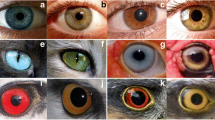Abstract
Alleles at the brown locus ofDrosophila melanogaster combined with homozygous scarlet provide a useful model to demonstrate minority advantage of males in mating. Heterozygotes with orange (O) eyes equal in numbers to homozygotes with red (R) eyes (10∶10 in both sexes) displayed no bias favoring either eye color, but each eye color was favored when males occurred in a minority ratio (2∶18). In direct observation of single females with equal numbers of males (3∶3) as controls,O males courted less and more slowly thanR males, but females mated with either type without bias. When unequal (4∶1), the minority males were successful at more than twice the frequency expected. Whether successful or not, the minority males did not change their level of courtship, and thus cannot be said to compensate for their frequency in any way. The time between first courtship and mating was less for the minority males than for the majority males. We discard the hypothesis that the minority male will be accepted immediately or ahead of a majority male, because the opposite tended to occur: that if a minority male courted first he was less likely to be successful than if he waited until the majority courted. Our results then are in conformity with the hypothesis that a female samples males and their courtship cues, thus becoming habituated to the majority of the first courting male, but she accepts a male with a cue different from that which she originally detected but avoided. That male is most often the minority.
Similar content being viewed by others
References
Brown, R. G. B. (1964). Courtship behaviour in theDrosophila obscura group. I:D. pseudoobscura.Behaviour 23: 61–106.
Burnet, B., and Connolly, K. (1974). Activity and sexual behaviour inDrosophila melanogaster. In van Abeelen, J. H. F. (ed.),The Genetics of Behaviour, North-Holland, Amsterdam.
Ehrman, L. (1966). Mating success and genotype frequency inDrosophila.Anim. Behav. 14:332–339.
Ehrman, L. (1968). Frequency dependence of mating success inDrosophila pseudoobscura.Genet. Res. 11:135–140.
Ehrman, L. (1972). A factor influencing the rare male mating advantage inDrosophila.Behav. Genet. 2:69–78.
Ehrman, L., and Spiess, E. B. (1969). Rare type mating advantage inDrosophila.Am. Nat. 103:675–680.
Geer, B. W., and Green, M. M. (1962). Genotype, phenotype, and mating behavior ofDrosophila melanogaster.Am. Nat. 96:175–181.
Manning, A. (1967). The control of sexual receptivity in femaleDrosophila.Anim. Behav. 15:239–250.
Pak, W. L. (1975). Mutations affecting the vision ofDrosophila melanogaster. In King, R. C. (ed.),Handbook of Genetics, Vol. 3, Plenum, New York.
Petit, C., and Ehrman, L. (1969). Sexual selection inDrosophila.Evol. Biol. 3: 177–223.
Pruzan, A. (1976). Effects of age, rearing, and mating experiences on frequency dependent sexual selection inDrosophila.Evolution 30:130–145.
Schwer, W. A. (1975). A study of minority advantage of certain mutant genotypes inDrosophila melanogaster. M.S. thesis, University of Illinois at Chicago Circle.
Spiess, E. B. (1968). Low frequency advantage in mating ofDrosophila pseudoobscura karyotypes.Am. Nat. 102:363–379.
Spiess, E. B. (1970). Mating propensity and its genetic basis inDrosophila. In Hecht, M. K., and Steere, W. C. (eds.),Essays in Evolution and Genetics in Honor of Theodosius Dobzhansky, Appleton-Century-Crofts, New York.
Spiess, E. B., and Langer, B. (1964). Mating speed control by gene arrangement carriers inDrosophila persimilis.Evolution 18:430–444.
Spiess, L. D., and Spiess, E. B. (1969). Minority advantage in interpopulational matings ofDrosophila persimilis.Am. Nat. 103:155–172.
Spieth, H. T. (1968). Evolutionary implications of sexual behavior inDrosophila.Evol. Biol. 2:157–193.
Wasserman, M. (1976). Experiments in minority advantage of mating activity of certain eye color mutants inDrosophila melanogaster. M.S. thesis, University of Illinois at Chicago Circle.
Author information
Authors and Affiliations
Additional information
This research was supported in part by National Science Foundation Grants GB-34206 to August 31, 1974, and BMS 72-02110 after that date.
Rights and permissions
About this article
Cite this article
Spiess, E.B., Schwer, W.A. Minority mating advantage of certain eye color mutants ofDrosophila melanogaster. I. Multiple-choice and single-female tests. Behav Genet 8, 155–168 (1978). https://doi.org/10.1007/BF01066872
Received:
Accepted:
Issue Date:
DOI: https://doi.org/10.1007/BF01066872




